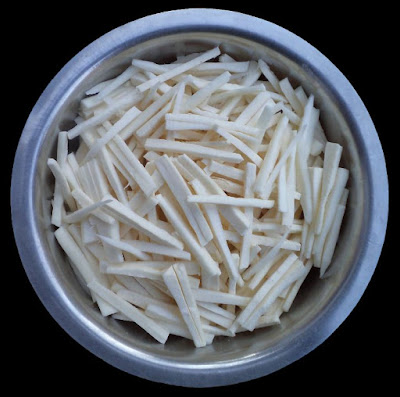KOZHIKKAL
Kozhikkal literally means chicken leg in Malayalam. It originated at Thalassery in northern Kerala where some of the tastiest cassava roots in the world are grown. Many delightful dishes are prepared using cassava. Tourists who eat the Thalassery cassava often come back every year to enjoy the taste. Cassava is the root from which tapioca is made.
Ingredients:
2) Chili powder - 1 tablespoon
3) Turmeric Powder – ½ teaspoon
3) Turmeric Powder – ½ teaspoon
4) Garlic – 3 cloves
5) Tender curry leaves – 2 sprigs
6) Salt – 2 teaspoons
7) Corn flour – 1 tablespoon
8) Maida (refined wheat flour) – 3 tablespoons
9) Coconut oil or other cooking oil to deep fry
To Cook:
Crush the garlic cloves and set aside. Peel the cassava root using a small knife to prise off the skin. Cut off the bony edge that attaches itself to the plant. Wash and cut into 3 inch long cylinders. Take a big sharp chef knife or a thin strong long blade knife to cut the hard cassava root. It is easier to cut uniformly with the portion near the handle of the knife while resting the tip of the knife on the cutting board.
Put the cassava cylinders vertically on the cutting board and cut thin slices of 3 mm. thickness. Now put 2 or 3 slices one on top of the other and cut lengthwise into juliennes (thin long strips) of the same thickness (3 mm.). If you cut breadthwise, the juliennes will shatter. While cutting, remember to remove the single fibrous bone that often runs through the length of the cassava.
Put all the cassava juliennes into a large bowl. Add the salt, the chili powder, the turmeric powder, the crushed garlic cloves and the curry leaves. Mix thoroughly with your hand while kneading gently. Sprinkle a little water and add the maida (refined wheat flour). Mix well. If it is too dry to catch the flour, sprinkle just a little more water (the maida is to give stickiness and body to the snack).
Now dust the corn flour and mix well again (the corn flour is to prevent the snack from absorbing too much oil and to give it the desired crispiness at the edges).
Put a wok or a deep pan on the stove. Pour in a litre of cooking oil and heat it up. When the oil is hot and about to smoke lightly, scoop up the cassava mix and roll and squeeze it with your fingers to make a 6 inch long cylindrical patty of around 1 inch thickness with some of the juliennes sticking out on all sides.
Slip gently into the hot oil. Put in 2 or 3 more but do not overcrowd the pan. Fry on medium heat, turning over the kozhikkal so as to fry up all the sides. When done, the outer side will be crisp and reddish orange in colour and the inner side will be fully cooked. Take out and drain the excess oil. Serve hot at home or cold if you are going on a picnic.













